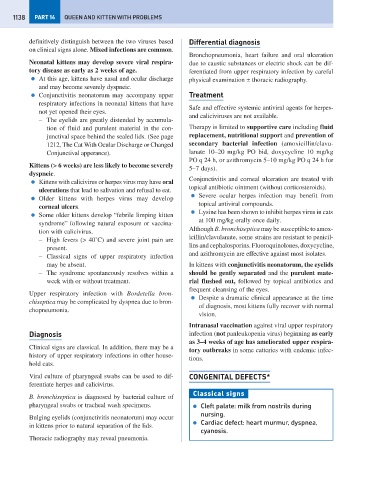Page 1146 - Problem-Based Feline Medicine
P. 1146
1138 PART 14 QUEEN AND KITTEN WITH PROBLEMS
definitively distinguish between the two viruses based Differential diagnosis
on clinical signs alone. Mixed infections are common.
Bronchopneumonia, heart failure and oral ulceration
Neonatal kittens may develop severe viral respira- due to caustic substances or electric shock can be dif-
tory disease as early as 2 weeks of age. ferentiated from upper respiratory infection by careful
● At this age, kittens have nasal and ocular discharge physical examination ± thoracic radiography.
and may become severely dyspneic.
● Conjunctivitis neonatorum may accompany upper Treatment
respiratory infections in neonatal kittens that have
Safe and effective systemic antiviral agents for herpes-
not yet opened their eyes.
and caliciviruses are not available.
– The eyelids are greatly distended by accumula-
tion of fluid and purulent material in the con- Therapy is limited to supportive care including fluid
junctival space behind the sealed lids. (See page replacement, nutritional support and prevention of
1212, The Cat With Ocular Discharge or Changed secondary bacterial infection (amoxicillin/clavu-
Conjunctival apperance). lanate 10–20 mg/kg PO bid, doxycycline 10 mg/kg
PO q 24 h, or azithromycin 5–10 mg/kg PO q 24 h for
Kittens (> 6 weeks) are less likely to become severely
5–7 days).
dyspneic.
Conjunctivitis and corneal ulceration are treated with
● Kittens with calicivirus or herpes virus may have oral
topical antibiotic ointment (without corticosteroids).
ulcerations that lead to salivation and refusal to eat.
● Severe ocular herpes infection may benefit from
● Older kittens with herpes virus may develop
topical antiviral compounds.
corneal ulcers.
● Lysine has been shown to inhibit herpes virus in cats
● Some older kittens develop “febrile limping kitten
at 100 mg/kg orally once daily.
syndrome” following natural exposure or vaccina-
Although B. bronchiseptica may be susceptible to amox-
tion with calicivirus.
icillin/clavulanate, some strains are resistant to penicil-
– High fevers (> 40˚C) and severe joint pain are
lins and cephalosporins. Fluoroquinolones, doxycycline,
present.
and azithromycin are effective against most isolates.
– Classical signs of upper respiratory infection
may be absent. In kittens with conjunctivitis neonatorum, the eyelids
– The syndrome spontaneously resolves within a should be gently separated and the purulent mate-
week with or without treatment. rial flushed out, followed by topical antibiotics and
frequent cleansing of the eyes.
Upper respiratory infection with Bordetella bron-
● Despite a dramatic clinical appearance at the time
chiseptica may be complicated by dyspnea due to bron-
of diagnosis, most kittens fully recover with normal
chopneumonia.
vision.
Intranasal vaccination against viral upper respiratory
Diagnosis infection (not panleukopenia virus) beginning as early
as 3–4 weeks of age has ameliorated upper respira-
Clinical signs are classical. In addition, there may be a
tory outbreaks in some catteries with endemic infec-
history of upper respiratory infections in other house-
tions.
hold cats.
Viral culture of pharyngeal swabs can be used to dif- CONGENITAL DEFECTS*
ferentiate herpes and calicivirus.
Classical signs
B. bronchiseptica is diagnosed by bacterial culture of
pharyngeal swabs or tracheal wash specimens. ● Cleft palate: milk from nostrils during
nursing.
Bulging eyelids (conjunctivitis neonatorum) may occur
● Cardiac defect: heart murmur, dyspnea,
in kittens prior to natural separation of the lids.
cyanosis.
Thoracic radiography may reveal pneumonia.

